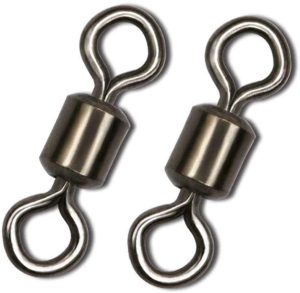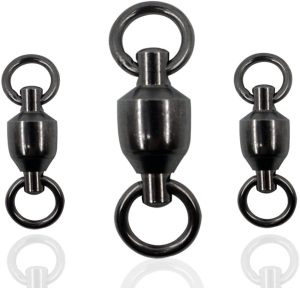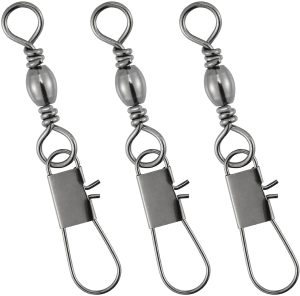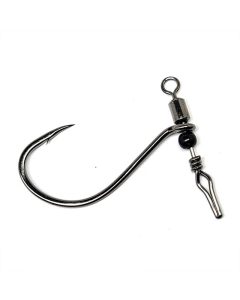When you’re fishing, you need to use the right equipment to make sure you have the best chance of catching a fish. One important piece of equipment is the swivel. Swivels allow your line to spin freely, which helps reduce tangles and keeps your bait from getting twisted up. In this article, we will discuss the different types of fishing swivels and how to choose the right one for your needs!
Table of Contents
What Is A Fishing Swivel?
A fishing swivel is a small metal device consisting of a pivoting joint in the middle, and two metal rings attached at the ends. The metal rings are connected to the joint with an anchor inserting into the joint, which allows them to rotate freely in any direction.
The main advantage of fishing swivels is that they prevent line twist when you’re fishing with a lure or a rig that tends to rotate in the water. The most common examples of this would be inline spinners and metal spoons, which rapidly rotate during retrieval, and thus quickly end up twisting your fishing line if you use them without a swivel.
A second advantage provided by fishing swivels is that they often come with a snap attached to one end, which makes it very convenient to switch out your lure or leader line quickly while fishing.
Because of these key advantages, fishing swivels are present in most fishing rigs used by anglers. Now let’s take a closer look at the different types of fishing swivels, and how to choose the right one.
What Are The Main Types Of Fishing Swivels?
The 5 main types of fishing swivels are:
- Barrel swivels
- Ball-bearing swivels
- Snap swivels
- Three-way swivels
- Finesse swivels
Together, these 5 swivel types cover more than 90% of all fishing applications where fishing swivels are used, and so are plenty to get you started. Let’s take a closer look at each of them below.
Barrel Swivel
 The barrel swivel is the original fishing swivel, and simply consists of a pivoting joint with two rings attached to either end. The joint in the middle is usually round, or sometimes a small barrel.
The barrel swivel is the original fishing swivel, and simply consists of a pivoting joint with two rings attached to either end. The joint in the middle is usually round, or sometimes a small barrel.
While barrel swivels are very cheap and easy to use, they don’t prevent line twist very effectively, since their rings don’t rotate as efficiently as those of a ball-bearing swivel.
See Barrel Swivels On Amazon | See On Walmart
Ball-bearing Swivel
 A ball-bearing swivel is an improved version of the barrel swivel, and comes with a ball bearing inside the pivoting joint. Due to this ball bearing, the rings of the swivel rotate much more freely than those of a standard barrel swivel, and thus prevent line twist more effectively.
A ball-bearing swivel is an improved version of the barrel swivel, and comes with a ball bearing inside the pivoting joint. Due to this ball bearing, the rings of the swivel rotate much more freely than those of a standard barrel swivel, and thus prevent line twist more effectively.
The main downside of ball-bearing swivels is that they are considerably more expensive than barrel swivels. Because of this, one option is to use them only when you’re fishing with a lure type that generates a lot of line twist.
See Ball-bearing swivels On Amazon | See On Walmart
Snap Swivel
 A snap swivel is an improved version of the barrel swivel that comes with a snap attached to one end, instead of the regular ring. The most common way to use a snap swivel is to tie your main fishing line to the ring of the swivel, and then use the snap to attach to the ring of a lure.
A snap swivel is an improved version of the barrel swivel that comes with a snap attached to one end, instead of the regular ring. The most common way to use a snap swivel is to tie your main fishing line to the ring of the swivel, and then use the snap to attach to the ring of a lure.
The great thing about using a snap swivel is that you can easily exchange the lure for another one at any time, which is much faster and easier than retying the line every time you want to change your lure.
See Snap Swivels On Amazon | See On Walmart
Three-way Swivel
As its name suggests, a three-way swivel consists of a pivoting joint that has three rings attached to it instead of two. The advantage of this setup is that you can add a separate leader line to one of the rings with a weight attached to the end of it.
The leader line used to attach the weight is usually weaker than the main line, which means that if the weight gets snagged on the bottom, it’s fairly easy to break it off without losing the rest of your tackle.
Three-way swivels are most commonly used for trolling rigs, since they allow you to troll a heavy weight close to the bottom without worrying too much about getting snagged.
Finesse Swivel
 The finesse swivel is a relatively new swivel type that’s used for fishing with a drop shot rig. It consists of a hook that is directly attached to the swivel, and can rotate around the axis of the swivel.
The finesse swivel is a relatively new swivel type that’s used for fishing with a drop shot rig. It consists of a hook that is directly attached to the swivel, and can rotate around the axis of the swivel.
While one end of the finesse swivel looks like a regular swivel ring (which is where you attach your main line), the other end looks like the clip-on ring of a drop shot weight.
The great thing about the finesse swivel is that you can use it to attach a drop shot weight via a leader line that is not directly tied to the swivel, but is instead clipped into it.
In case your weight gets snagged on the bottom, this design allows you to pull the line attached to the weight off the swivel, so you’ll only lose the weight, but not the rest of your rigging.
Swivel Sizes
Fishing swivel sizes are classified with an aught scale similar to fishing hooks, with the smallest size starting at 12, and gradually increasing as the numbers go down to size 1. After reaching size 1, swivel sizes switch to 1/0, and go up to size 12/0, which is the largest swivel size.
In general, it’s best to choose the smallest swivel size that you can get away with, since that won’t spook fish as much as an oversized swivel. For example, when fishing for trout, a size 12 swivel is most often the best choice.
However, when fishing for bigger fish with heavy lines, it’s necessary to increase the size of your swivel, since that also increases the amount of weight that the swivel can bear without breaking.
Snap Swivel Size Chart
Barrel Swivel Size Chart
What Is The Difference Between A Barrel Swivel And A Crane Swivel?
A crane swivel is an intermediate form between a barrel swivel and a ball-bearing swivel. It comes with highly polished metal parts that enable its rings to rotate better than those of a barrel swivel, but not as well as those of a ball-bearing swivel.
When in doubt, it’s usually best to opt for a ball-bearing swivel, since that guarantees the best performance. This is especially important when fishing with rotating lures, such as inline spinners and spoons.
How Do You Choose A Swivel For Fishing?
Choosing the right swivel depends on what fishing technique and what fishing lure you want to use. If you’re fishing with lures that have a heavy rotating action, it’s essential to use the best swivel you can find, which would be a ball-bearing swivel.
On the other hand, if you’re fishing with lures that don’t rotate, or with fishing rigs that don’t don’t twist up the line, you can opt for a simple barrel swivel. Also, if you want to have the flexibility of changing up your lure or presentation at any time, it makes sense to use a snap swivel, which you can use to attach a different lure or leader line very quickly.
Do Swivels Spook Fish?
In most cases, fishing swivels don’t spook fish, and you can attach them directly to your lure without any problems.
However, if you’re dealing with finicky fish, a swivel may spook them. This is most often the case when fishing in heavily pressured fisheries, where the fish have learned to avoid anything that comes with a fishing line and/or terminal tackle attached to it.
Another scenario where swivels may spook fish is when fishing in crystal clear waters, such as trout streams. And obviously the most challenging situation is when dealing with pressured fish in very clear waters.
If you find yourself in any of the situations above, you can still use a swivel, but shouldn’t attach it directly to your lure. Instead, tie a 2 to 3 foot fluorocarbon or monofilament leader between the swivel and the lure. That way, you still get the benefit of the swivel, but without spooking the fish.
When To Use a Snap Without a Swivel
Instead of using a snap swivel you can opt to use a snap without a swivel attached to it. This is a good option if your lure or rig doesn’t really generate line twist, and if you’re dealing with heavily pressure fish that spook easily (especially when fishing in very clear water).







































![Air gun 101: The differences between .177 & .22 – Which jobs they do best ? [Infographic]](https://airgunmaniac.b-cdn.net/wp-content/uploads/2024/11/1773-150x150.jpeg)
